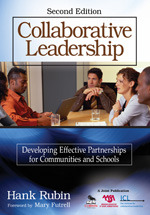Collaborative Leadership
Developing Effective Partnerships for Communities and Schools
- Hank Rubin - Rochester Area Community Foundation, Institute for Collaborative Leadership, Winona State University, USA
Foreword by Mary Futrell
"Hank Rubin has fashioned a new and needed vision for collaborative leadership that can work anywhere—especially in schools. Rubin properly argues that public school success is not a top-down enterprise; it is a collaborative one. He reminds us that well-managed relationships and intentional collaboration are essential skills for all school leaders, from those teaching in classrooms to those running state agencies. This is a must-read for teachers and other champions of school policies and practices that support the success of every student."
—John Wilson, Executive Director
National Education Association
"Hank Rubin translates complex, contextually driven processes into digestible bites. The text is compelling, refreshing, and a joy to read."
—Chris Ferguson, Program Associate
Southwest Educational Development Laboratory
"Rubin's book provides an eloquent and practical articulation of collaborative leadership and its potential to improve the partnership of communities and public schools."
—Wendy Caszatt-Allen, Teacher and Author
Mid-Prairie Middle School, Kalona, IA
Build successful collaborative relationships in your school—and watch resources for student achievement soar!
Written to inspire and support educators in becoming transformative, collaborative leaders, this updated edition of a best-selling resource demonstrates how educators can use collaboration skills to help shape school culture and build and maintain strong schoolwide relationships that contribute meaningfully to students' learning.
Visionary Hank Rubin provides a broad overview of collaboration in education and lays the foundation for working with colleagues, establishing strong partnerships, and cooperating with students to achieve goals. Updated with the latest research and filled with practical examples, this resource examines 14 phases of collaboration and helps educators:
- Understand the knowledge, skills, and personal characteristics necessary to foster successful collaboration
- Nurture relationships between students and the institutions and individuals associated with learning
- Build collaborative community relationships that support an instructional agenda
- Incorporate the study of collaboration and related reflective activities into leadership practice
By applying these vital principles of collaboration to their work, educators will discover what a school of collaborative excellence is capable of achieving!
"Hank Rubin has fashioned a new and needed vision for collaborative leadership that can work anywhere—especially in schools. Rubin properly argues that public school success is not a top-down enterprise; it is a collaborative one. He reminds us that well-managed relationships and intentional collaboration are essential skills for all school leaders, from those teaching in classrooms to those running state agencies. This is a must-read for teachers and other champions of school policies and practices that support the success of every student."
"Rubin’s book provides an eloquent and practical articulation of collaborative leadership and its potential as a powerful tool to improve the partnership of communities and public schools at all levels, from clients to practitioners to the utilization of community resources."
"Our district is embarking upon the most aggressive strategic plan in our history, and the information contained in this book regarding the attributes of community collaboration serves our district well. I encourage persons seriously interested in community collaboration to review the ideas of Hank Rubin. This book is a must-read for those interested in collaborative leadership.”
“Hank Rubin translates complex, contextually driven processes into digestible bites. The text is compelling, refreshing, and a joy to read. It made me reconsider all that I know about collaboration and where we are as educators.”
“Provides the educator, community and non-profit organizational leaders, and grant makers with explicit information on steps to ensure successful collaborations that will make the lives of students better. Rubin discusses 24 skills and attributes that foster successful collaboration. Collaborative leaders can use this list to analyze their own strengths and weaknesses and select collaborative partners who have skills and attributes that will mesh into a workable whole.”
"The author demonstrates how institutional goals are realized when leaders balance their own sense of ownership and responsibility with the vision and core values of their institutions. This is a must-read for school administrators and those in management who are interested in knowing how collaboration works effectively and successfully toward institutional goal attainment."
"This handbook should be read, thoughtfully reflected upon, and applied by leaders who seek to collaborate with diverse interests to accomplish common goals. All too often, groups will sacrifice what they have in common because of disagreements on relatively minor issues. This handbook is designed for those who understand that much more can be accomplished through collaboration than through conflict. It should be regarded as essential reading for educational leaders at all levels and in a wide variety of positions who seek to apply collaborative strategies to bring about fundamental and enduring improvement in the American educational system."
"In Hank Rubin’s latest book, he emphasizes the importance of teachers as leaders. It is crucial that teachers not only know their content and have pedagogical skills, but must take control of their profession by developing a collaborative learning environment in which all participants are continuous lifelong learners. Learning together makes for a meaningful, relevant educational experience.
"The complexity of both the educational task and its context necessitates new thinking about the traditional concepts and roles associated with educational leadership and school management. This book lays out a guide to these new concepts that incorporate collaborative, symbiotic relationships that are networked within the school’s social system and that reflect a more 'adaptive systems' characteristic with an emphasis on organizational learning."
Although the text is informative, it is geared more toward administration than the teacher.
